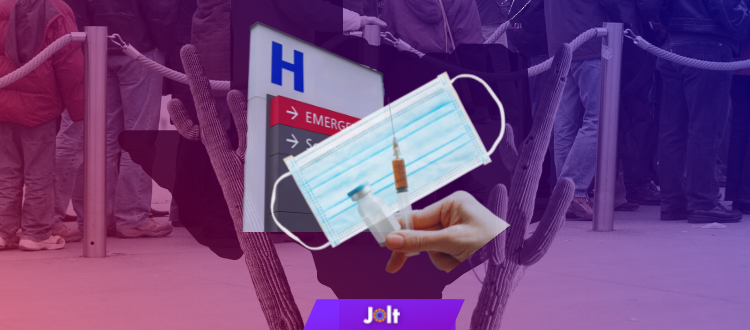By now, everyone probably knows someone who has had COVID-19 in the past few weeks. Following the holidays, we knew cases would surge, but few would have predicted that the omicron variant would push the United States past 1,000,000 case-per-day. 1 out of every 3 Texans is testing positive for COVID-19 and the numbers continue to rise. Beyond the staggering numbers, the state of the virus and our public health response continues to change daily, so Jolt is here to get you all caught up.
Where are the tests?
While the Omicron variant is considered a “mild” version of the Coronavirus, it is 70 times more contagious and becoming increasingly responsible for breakthrough cases of those who have been vaccinated and boosted. Because of its similar symptoms to Texas allergies, many don’t know that they have it which has led to an increased call for testing. If you have tried to get tested, you know that it is tough to find a testing facility, and if you do find somewhere that has tests available, you’re probably looking at a long wait time. Relief may be coming soon, as FEMA announced plans to open six emergency testing centers across Texas in Bexar, Cameron, Dallas, Harris, Hidalgo and Tarrant counties.
With so many people getting tested right now, we are also seeing a test positivity rate that has risen to 34%. That’s right, one in three COVID-19 tests in Texas are coming back positive, with many more people who likely have contracted the virus, but have not had access to a test. We now clearly know that the omicron variant is the most transmissive version of the virus we have yet seen.
Hospitalizations
The number of people hospitalized with COVID-19 has increased nationwide, and Texas is no different. As of Jan 6, 9216 people were hospitalized with COVID-19 in our state, which is an increase from recent weeks, but only about half of the previous peak. What’s more concerning is that the number of ICU beds available across Texas has dipped to less than 400 available beds, as of Thursday.
The high transmission of the Omicron variant is certainly pushing hospitalizations up, but on average, the variant is proving to be less severe than Delta. In fact, the rise in hospitalizations is in part being attributed to people who are hospitalized for something other than COVID-19, but they happen to come back with a positive test. These are called incidental cases, where COVID-19 is not the reason an infected individual is in the hospital, and they have been included in the hospitalization numbers all along, but recent reports suggest that a higher number of reported hospitalizations are incidental with Omicron than with previous variants.
Vaccination and Precautions
Above all, the fact that so many people in hospitals have contracted COVID-19 highlights the need to get vaccinated and take extra precautions to avoid crowds, at least until this surge is behind us. Despite widespread misinformation, the science is clear that getting vaccinated significantly decreases the chances of having a severe case of COVID-19.
Although getting vaccinated and boosted does not mean you cannot contract or spread the coronavirus, it does reduce your odds of experiencing hospitalization, death, or other long-term health complications. With so few ICU beds available, it is critical that we do everything we can to not only protect ourselves but also protect our family, friends, neighbors and fellow Texans.
